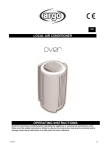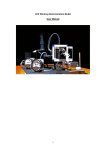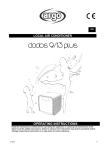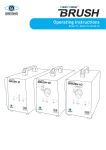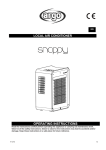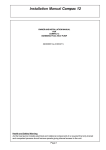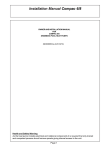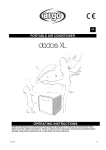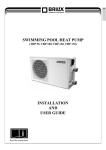Download Brilix THP 120 User guide
Transcript
EN SWIMMING POOL HEAT PUMP (THP 55, THP 100, THP 120, THP 170) INSTALLATION AND USER GUIDE i Read the instructions EN Contents I. II. III. IV. V. VI. VII. VIII. IX. Performance and properties ................................... 4 System design ........................................................ 4 Performance ........................................................... 5 Dimensions ............................................................ 6 Preparations for installation ................................... 6 Operating the control unit ...................................... 9 Connection diagram ............................................. 12 Maintenance ......................................................... 13 Troubleshooting ................................................... 13 Thank you for choosing our product and for your trust in our company. To ensure that you can fully enjoy the product, please read these instructions carefully and strictly follow the user guide so as not to damage the device and to avoid unnecessary injuries. 2 EN I. Performance and properties High performance Our heat pumps are very efficient in transferring heat from air to water in the pool. They can provide savings of up to 80% in energy compared to an electric heater. Long life The heat exchanger is made from a PVC/titanium composite pipe resistant to the long-term effects of pool water. Simple operation and maintenance The device is easy to control: switch it on and set the required temperature of the water in the pool. The system incorporates a microcomputer control unit which allows all the operational parameters to be specified. The state of operation can be displayed on the control unit through an LCD display. II. System design colder air depleted of energy compressor evaporator pump air flow air flow swimming pool cleaner hot air compressor heat exchanger swimming pool ventilator condenser water heat exchanger capillary tube evaporator (energy collector) water outflow water inlet • Heat pumps make use of free heat from the sun by collecting and absorbing energy from the outside air. • This device contains a ventilator which draws the outside air in and makes it flow over the surface of the EVAPORATOR (energy collector). The liquid coolant in the EVAPORATOR pipeline absorbs the heat from the outside air and the coolant vaporises. • The warm gas in the pipeline passes through the COMPRESSOR which gathers the heat and increases the temperature to generate very hot gas which then passes to the CONDENSER (water heat exchanger). This is where the heat exchange occurs - the hot gas transfers heat to the colder water from the pool which is circulating through the coil. • The pool water is heated and the hot gas is cooled when passing through the CONDENSER pipeline – it regains its liquid form and, after the passage through the CAPILLARY TUBE, the whole process recommences. • The current technology used in the heat pump allows efficient use even at an outside air temperature of 7 to 10 ºC. For tropical and subtropical climates, this means that 26 to 32 ºC may be maintained in the pool under almost any conditions all year round. In northern countries, the heat pump considerably extends the swimming season. 3 EN III. Performance properties Performance properties of a monoblock-type heat pump for swimming pools Code THP 55 THP 100 THP 120 THP 170 W 5500 9900 11800 17300 BTU 19000 34000 41300 59500 Heat input W 1240 1940 2650 3670 Operating current for heating A 5,5 9,6 13,3 18 1 1 Nominal heat output Current supply V/phase/Hz 220-240/1/50 Number of compressors 1 1 Scroll Compressor Number of ventilators 1 1 1 1 W 25 50 50 50 Ventilator speed RPM 950 950 950 950 Noise dB(A) 53 55 57 59 Mains pipe mm 50 50 50 50 Water flow m3/h 2-4 4-6 6-8 8-10 Decrease in water pressure kpa 20 20 20 20 Coolant (R407C) kg 0,8 1,3 1,3 2,1 935 1090 1090 1165 360 370 370 470 H 550 615 615 685 L 1060 1140 1140 1195 380 400 400 485 600 660 660 730 40 62 65 99 48 71 77 104 Input of ventilators L Net dimensions Packaged dimensions W W mm mm H Weight net gross kg 4 EN IV. Dimensions Dimensions of heat pumps (monoblock-type) for swimming pools Model THP 55 THP 100 THP 120 L 1000 1090 1090 W 360 370 370 H 550 612 612 E 81 84 84 F 200 270 270 Dimension Unit: mm Model THP 170 Dimension L 1165 W 470 H 685 A 440 B 760 F 325 G 81,5 Unit: mm V. Preparations for installation 5.1 Selection of the installation position • The heat pump has to be installed in a spacious and well ventilated place. • Its position has to guarantee adequate free space for the exhaust (the location of the air inlet is shown in the diagram on the next page). • The heat pump has to be situated close to a drain or vent so as to make water discharge easier. • The installation base or brace has to be firm enough to ensure smooth operation of the device. • Make sure the device, when installed, is situated vertically, without any inclination. • Do not install the device in places where there is contamination, corrosive gas or where dirt or fallen leaves accumulate. • The heat pump must not be installed in the vicinity of an inflammable or explosive environment or near things that are a common cause of fire. • Maintain the distances from obstacles as indicated with arrows in the picture below. 5 EN Model with horizontal discharge min. 1000 mm air inlet air inlet min. 1000 mm from above min. 1000 mm min. 1000 mm air outlet min. 2000 mm Requirements for free space around the horizontal heat pump Model with vertical discharge more than 1000 mm air inlet min. 1000 mm from above min. 1000 mm min. 1000 mm air inlet air inlet air outlet min. 2000 mm from above Requirements for free space around the vertical heat pump Warning: • Do not put your hand or any object into the air outlet or ventilator, as this could damage the device and cause an injury. • In the event of any abnormalities, switch off the device immediately and contact an expert technician. • If needed, you should place barriers next to the device to keep children away from the running heat pump. 6 EN 5.2 Installation diagram back pressure valve filter chlorinator water pump trap back pressure valve 7 EN VI. Operating the control unit Preliminary steps before start-up A) Inspect the heat pump • Visually check the device or the pipeline within the device to ensure that the device was not damaged during transport. • Check that the ventilator does not touch any other part of the device. B) Check the electric connections • Check that the electricity supply complies with the technical data in this guide or on the device identification plate. • Check that the wiring is correctly and safely connected in accordance with the wiring diagram. An adequate earth connection is necessary to protect from electric shocks. 6. 1 Picture of the control unit A. On / off button. B. Mode selector – automatic, heating or cooling. There are indicator lights for the selected modes. C. or Buttons for changing the numbers displayed. D. Button for setting the switch-on time. E. Button for setting the switch-off time. F. Button for adjusting the time. 6. 2 How to activate the heat pump When connected to a power supply, the control unit will show the time. This means the device is in standby mode. Pushing the button will activate the heat pump. The control unit display will now show the temperature of the input water. Standby Operation 8 EN 6. 3 How to change the mode Press the button to change the mode to automatic, heating or cooling. The appropriate indicator light will be illuminated on the right side of the control unit. 6.4 How to check the settings and the current measured values In the standby mode or operation mode, use the buttons measured values Parameter or to find the parameter 0-A and the current Meaning Range Factory setting 0 Setting the return water temperature (cooling mode) 8-28ºC 12ºC 1 Setting the return water temperature (heating mode) 15-40ºC 40ºC 2 Defrosting cycle 30-90 min 45 min 3 Setting the pipeline temperature for the start of defrosting 0- –30ºC -7ºC 4 Setting the pipeline temperature for the end of defrosting 2-30ºC 13ºC 5 Maximum defrosting time 1-12 min 8 min 6 Number of systems 1-2 1 7 Restart after electricity supply failure 0-1 1 (yes) 8 Type: only cooling 0/ heating and cooling 1/ heating and cooling + additional heating 2/ heating only 3 0-3 1 9 Different water pump operating mode 0 water pump works uninterruptedly 1 water pump works together with the heat pump 0-1 0 A Setting the return water temperature (automatic mode) 8–60ºC 28ºC B Actual temperature of input water -9 +90ºC C Actual temperature of output water -9 +90ºC D Pipeline water temperature in system 1 -9 +90ºC E Pipeline water temperature in system 1 (only for a double system) -9 +90ºC F Surrounding temperature -9 +90ºC Parameter 1 Current measured value 9 EN 6. 5 How to change parameter settings 1. In the standby mode, use buttons or to find the parameter 0-A and the current measured values for B-F. 2. Simultaneously, for five seconds, press buttons and to activate parameter setting. 3. Change the parameter value until you hear a beep and until the parameter is indicated on the display as a flashing value. 4. If no button is pressed on the control unit within five seconds, the electronics will save the data automatically and will return to the standby mode. 6. 6 How to set the clock 1. In the standby mode, press button . The hour digits will start flashing to show that they can be changed using buttons or . 2. Again, press button . The minute digits will start flashing to show that they can be changed using or buttons . 3. To confirm the time setting, press button . 6. 7 How to set the switch-on and switch-off time using the timer a) Press button to activate the timer switch-on time setting mode. The hour and minute digits will start flashing. b) Again, press button to activate clock setting. The hour digits will start flashing to show that they can be changed using buttons and . c) Press button to confirm the setting. The display will return to standby mode. The green indicator light for the switch-on time of the timer will be illuminated. d) To set the switch-off time of the timer, take the same steps. Instead of button use button . The green indicator light for the switch-off time of the timer will be illuminated. Note: You can set both the switch-on and switch-off times of the timer, or only one. 6. 8 How to cancel / reset the timer function For activation, press button or . The appropriate indicator light will start flashing. To cancel / reset the timer function, press button . 6. 9 Lock / Unlock the keyboard When you have finished setting the parameters, pressing buttons and simultaneously for three seconds (until a beep is heard) will lock the keyboard. To unlock it, press these two buttons simultaneously for other three seconds. 10 EN VII. Connection diagram Models: THP 55, THP 100, THP 120, THP 170 CONNECTION DIAGRAM FOR A SWIMMING POOL HEAT PUMP four-way valve ventilator pump electric heating unit blue green / yellow red four-way valve common black on blue sensor 1 sensor 2 sensor 3 1 exhaust temperature regulator 2 high-pressure sensor low-pressure sensor water pressure sensor earth common blue blue green / yellow black blue to electricity supply surrounding pressure green / yellow temperature of coil blue temperature of output water red blue temperature of input water red control unit connected by cable to water pump electricity supply Power conductor cross-sections Code THP 55 THP 100 THP 120 Cross-section 1,5 mm2 11 THP 170 EN VIII. Maintenance • Check that the device water inlet is open. It is necessary to avoid low water and air flows into the device because they could worsen its performance and reliability. You have to clean the swimming pool filter regularly to avoid damage to the device as a result of a dirty or blocked filter. • The space around the device has to be dry, clean and well ventilated. Clean the side heat exchanger regularly in order to maintain good heat exchange performance and save energy. • The cooling system may only be serviced by certified maintenance engineers. IX. Troubleshooting CONTROL UNIT FAULT CAUSE SOLUTION PP 1 Input water temperature Sensor fault Broken or short-circuited sensor Check or replace the sensor PP 2 Output water temperature Sensor fault Broken or short-circuited sensor Check or replace the sensor PP 3 Fault in coil sensor 1 Broken or short-circuited sensor Check or replace the sensor PP 4 Fault in coil sensor 2 Broken or short-circuited sensor Check or replace the sensor PP 5 Fault in surrounding temperature sensor Broken or short-circuited sensor Check or replace the sensor PP 6 The temperature of input and output water is too high Insufficient water output or too small difference in water pressure Check water output. Check that ventilation is not blocked. PP 7 Protection against freezing for cooling Insufficient water output Check water output. Check that ventilation is not blocked. EE 1 High pressure protection fault or system 1 protection fault Defective protection of system 1 Check each place of system 1 protection, remove the defect as stated in the fault table on the system protection card EE 2 High pressure protection fault or system 2 protection fault Defective protection of system 2 Check each place of system 2 protection, remove the defect as stated in the fault table on the system protection card EE 3 Fault in the water pressure sensor Water circuit without water or with too little water Check water output. Make sure the installation is not blocked. Poor-quality or missing phase (for a three-phase device) Poor-quality or missing phase Check power cable wiring. EE 5* PP6 fault occurs three times in 30 minutes Insufficient water output or too small difference in water pressure Check water output. Check that installation is not blocked. EE 8 Fault in communication between the control unit and electronics Fault in connection between the control unit connected with a cable and electronics Check wiring. Display empty Display empty Defrosting underway * Notes: One minute after its activation, the water pump starts measuring the temperature of the input and output water. If the difference in temperatures is higher than 13ºC for 10 seconds, the electronics will stop the heat pump and the control unit will display fault PP6; after three minutes the heat pump will start again. If it stops three times in 30 minutes because of fault PP6, the control unit will display fault EE5. It will be possible to start the heat pump again only after disconnecting and re-connecting the power supply. When the pump is not operating or the device is in heating mode, the system does not monitor abnormal temperature differences. 12 EN WARNING • Before installation, check that the electricity supply complies with the technical conditions of your heat pump. The details are specified on the plaque fitted to the device or in this guide. • Install recommended electric protective devices in accordance with local regulations. • The heat pump has to be earthed to protect you from electric shocks due to possible short circuits. • This guide includes a wiring diagram. • For safety reasons, do not make any unauthorised changes to the heat pump or carry out repairs to the device without authorisation. • Do not insert any objects into the pump when it is operating as they might touch the ventilator and damage it or cause accidents (especially in the presence of children). • Do not use the heat pump without a grille or protective plate as this could result in accidents or abnormal operation of the device. • If water gets into the device, immediately contact the supplier. The device may be used again only after examination by our technicians. • Unauthorized technicians may not adjust the sensors, valves or control units of the device. Conditions of guarantee The conditions of guarantee are governed by your supplier’s general conditions of trade and conditions of guarantee. Safe disposal of the product after its service life After its service life is over, have the product disposed of ecologically by a specialized company. Warranty claims and servicing Warranty claims are governed by applicable consumer protection legislation. In the event a fault cannot be rectified, please contact your supplier in writing. Date................................................................ Supplier 13













